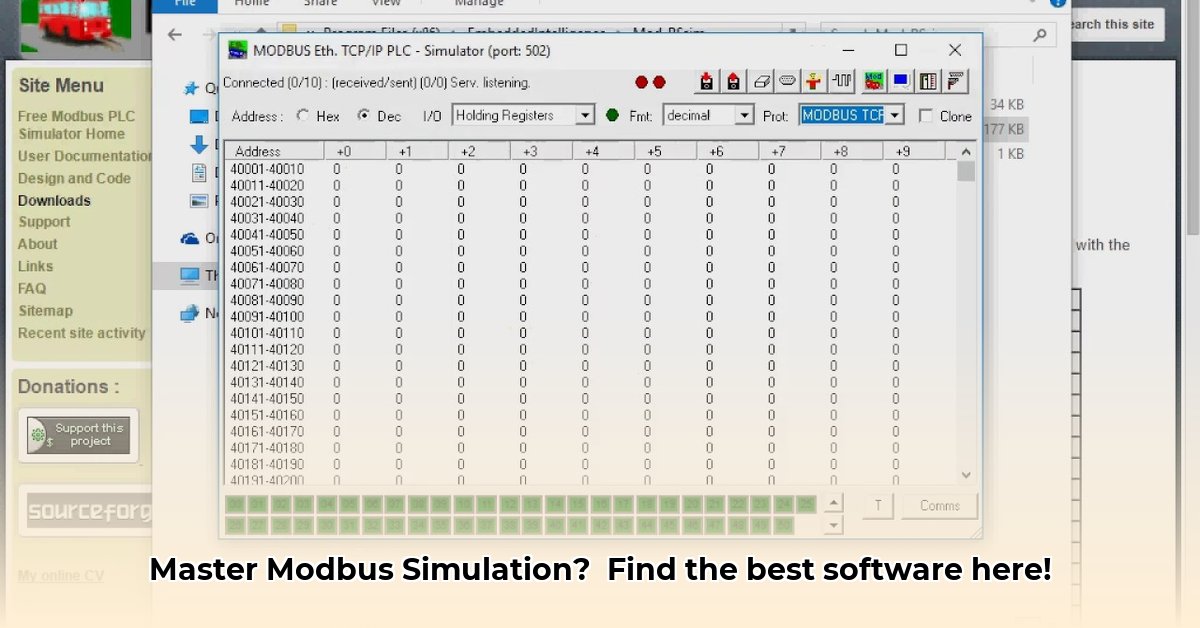
Picking the right Modbus simulator software is a critical decision for anyone involved in industrial automation. This comprehensive guide will help you navigate the market, understand key features, and ultimately choose the perfect software for your needs. We'll explore various solutions, highlighting their strengths and weaknesses, while offering a practical, step-by-step approach to selection.
Understanding Your Modbus Simulation Needs
Before diving into specific software, define your project's requirements. What aspects of Modbus communication will you be testing? Will it involve basic functionality checks, stress tests, or complex industrial simulations? This initial assessment significantly impacts your software choice. Are you, for instance, testing high-speed data acquisition? If so, raw performance benchmarks become paramount. For simpler tasks, this may be less of a concern.
Essential Features of a Robust Modbus Simulator
A powerful Modbus simulator is more than just a slave device mimic; it's a vital tool for development and comprehensive testing. Key features include:
Protocol Versatility: Support for both Modbus TCP/IP and RTU protocols is essential, ensuring compatibility across various industrial networks. Lack of support for either could severely limit your testing capabilities.
Integration Seamlessness: Effortless integration with your existing development environment (such as Python, VBA, or others) is crucial for efficient workflow and faster development cycles. Clunky integration significantly slows the process.
Intuitive Visualization: Clear, real-time visualization tools (graphs, charts, etc.) are invaluable during debugging. Visual clarity dramatically reduces troubleshooting time.
Advanced Scripting: The ability to create custom scripts for complex simulations is key for advanced testing scenarios and automation of repetitive tasks. This significantly improves testing efficiency.
Scalability: Choose a solution that can adapt to larger, more complex systems as your projects evolve. Scalability ensures your investment remains relevant for years to come.
Comparing Modbus Simulators: A Qualitative Overview
The Modbus simulator market is diverse. Established, reliable options like Modbus Poll exist alongside newer entrants with specialized features. Direct, numerical comparisons are difficult due to the absence of a standardized benchmark. We instead focus on qualitative aspects:
| Feature | Modbus Poll (Example) | Example Software: Witte Solutions (Example) | Other Options (Further Research Needed) |
|---|---|---|---|
| Protocol Support | Modbus RTU, ASCII, TCP/IP | Modbus RTU, ASCII, TCP/IP | Highly Variable |
| Programming/Scripting | Limited built-in scripting; extensions possible | Varies depending on the specific software | Widely Variable |
| Visualization | Basic | Often includes advanced graphics and charting | Highly Variable |
| Ease of Use | Excellent; highly user-friendly | User-friendliness varies widely | Highly Variable |
Note: This table serves as a starting point. Thorough research is crucial before making a final decision. Each project has unique demands.
Choosing Your Modbus Sim Software: A Step-by-Step Guide
Selecting the right software is a multi-step process. Think of it as building a solid foundation for your project.
Reiterate Your Needs: Refine your list of essential features. What protocols are absolutely required? How will the software integrate into your existing workflow?
Explore Software Options: Research various software packages. Explore both established and newer solutions, considering their features and user reviews.
Leverage Trial Periods: Many vendors offer trial versions. Utilize these to assess usability and functionality in a realistic environment. This significantly reduces risk.
Consult Online Communities: Review user feedback in forums and online communities. Real-world experiences often provide insights unavailable in marketing materials.
Budget Accordingly: Balance software costs against its capabilities and potential ROI. The cheapest option isn't always the best; consider long-term value.
Real-World Applications and Future Trends
Modbus simulators dramatically reduce development time by enabling safe, virtual testing. This simplifies debugging, catches errors early, and saves significant costs. Future trends point towards increased integration with other industrial protocols (OPC UA, MQTT) and the rise of cloud-based solutions. However, standardization across platforms remains a challenge.
Choosing the right Modbus simulator is a crucial investment. By following this guide and considering your specific needs, budget, and future goals, you can select a tool that optimizes your workflow and project success. The best solution isn't just powerful; it's user-friendly and seamlessly integrated into your existing processes.
⭐⭐⭐⭐☆ (4.8)
Download via Link 1
Download via Link 2
Last updated: Monday, May 26, 2025